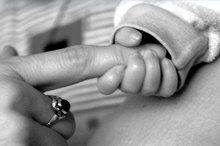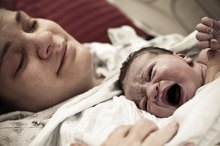What does fact checked mean?
At Healthfully, we strive to deliver objective content that is accurate and up-to-date. Our team periodically reviews articles in order to ensure content quality. The sources cited below consist of evidence from peer-reviewed journals, prominent medical organizations, academic associations, and government data.
The information contained on this site is for informational purposes only, and should not be used as a substitute for the advice of a professional health care provider. Please check with the appropriate physician regarding health questions and concerns. Although we strive to deliver accurate and up-to-date information, no guarantee to that effect is made.
Light Pink Spotting While Breastfeeding
For the new mother, the question of when fertility will return after childbirth is a common one. While every woman's body is different, the most common determinant of when her period will return is whether she is breastfeeding or not. Spotting may be indicative of the return of menstruation, or may be part of the healing process following childbirth.
Lactational Amenorrhea
Amenorrhea is the lack of menstrual bleeding. Lactational amenorrhea is the lack of menstrual bleeding due to breastfeeding after childbirth. The hormone that stimulates milk production, called prolactin, also inhibits ovulation, according to Women's Health Queensland Wide. When ovulation is inhibited, so is the return of menstruation. The amount of time that lactational amenorrhea lasts is determined by how many times a day you breastfeed your child, and for how long you continue nursing.
- Amenorrhea is the lack of menstrual bleeding.
Guidelines to LAM
Causes of Not Having Menstrual Period in 6 Months
Learn More
The Lactational Amenorrhea Method (LAM) is a method of family planning for postpartum women and families 2. Family Health International (FHI) identifies three criteria to LAM that must be met to ensure protection from unplanned pregnancy. The first criteria is amenorrhea. Second, you must be fully or nearly fully breastfeeding, also called exclusive breastfeeding. Lastly, LAM is most reliable within the first six months postpartum.
- The Lactational Amenorrhea Method (LAM) is a method of family planning for postpartum women and families 2 identifies three criteria to LAM that must be met to ensure protection from unplanned pregnancy.
Full Breastfeeding
Full breastfeeding, or exclusive breastfeeding, is recommended for the first six months for the health of your new baby as well as to have the highest rate of effectiveness of LAM. According to FHI, pregnancy rates during lactational amenorrhea within the first 6 months postpartum were very low, even if the mother breastfed and offered formula supplements to her baby. However, since it is the effect of frequent breastfeeding on a woman’s body that causes amenorrhea, adding formula to baby’s diet may decrease his desire to breastfeed often, resulting in the return of menstruation.
The End of Amenorrhea
Do Estrogen Levels Return to Normal After Breastfeeding?
Learn More
The end of amenorrhea is outlined by FHI as two days in a row of bleeding or spotting. This does not include the bleeding or spotting that occurs immediately after childbirth. If bleeding or spotting occurs within the first 56 days after childbirth, it is not considered menstruation. From day 57 postpartum and after, if you have two consecutive days of vaginal bleeding or spotting, amenorrhea has ended and it is possible menstruation has returned.
- The end of amenorrhea is outlined by FHI as two days in a row of bleeding or spotting.
- If bleeding or spotting occurs within the first 56 days after childbirth, it is not considered menstruation.
Considerations
Following childbirth, a woman’s menstrual cycle may return beginning with ovulation and followed by her first period. Therefore, you may be fertile, having ovulated, prior to having your first menstrual period with vaginal bleeding or spotting.
Related Articles
References
- National Institutes of Health: Absence of Menstruation
- Family Health International: Consensus Statement: Lactational Amenorrhea Method for Family Planning
- Van der Wijden C, Kleijnen J, & Van den Berk T. "Lactational amenorrhea for family planning." Cochrane Database of Systematic Reviews. 2015 Oct 3(1): CD001329. Accessed via private subscription.
Writer Bio
Leslie Stamper has been covering medicine and health since 2005. A registered nurse and clinical nurse educator with more than six years experience in obstetrics and neonatal intensive care, she holds a Bachelor of Science in Nursing degree from Bethel University, and a Masters of Science degree in Nursing Education from the University of Minnesota.









